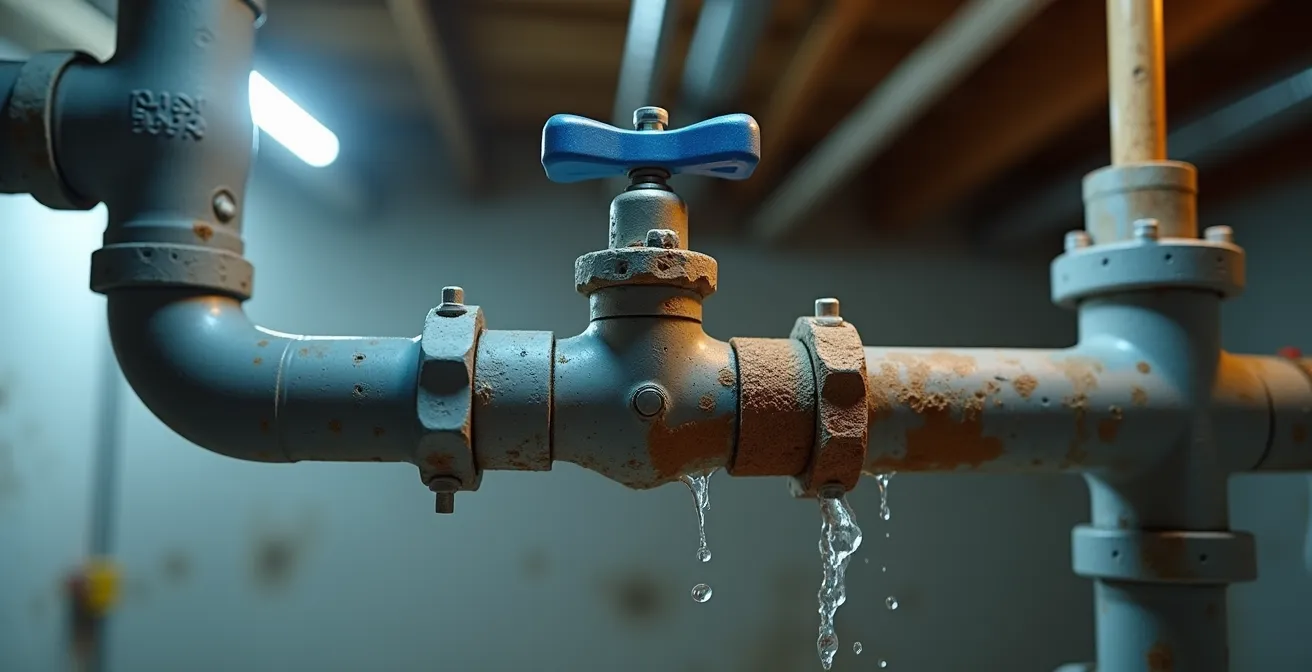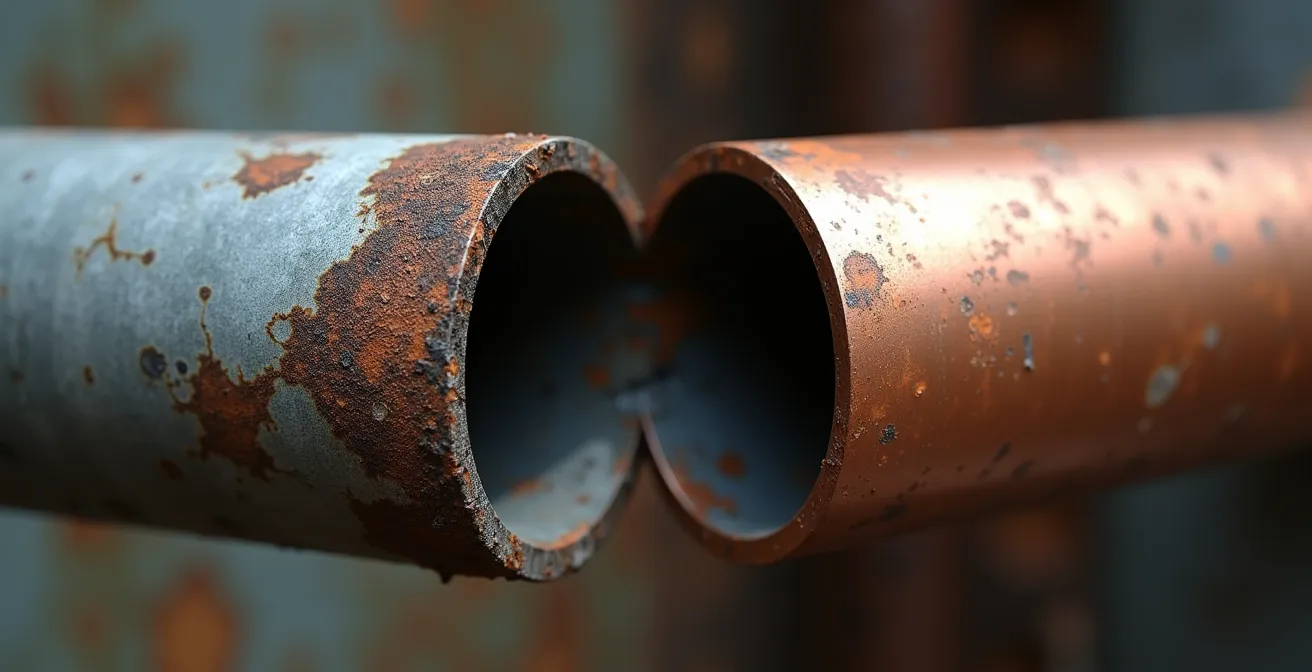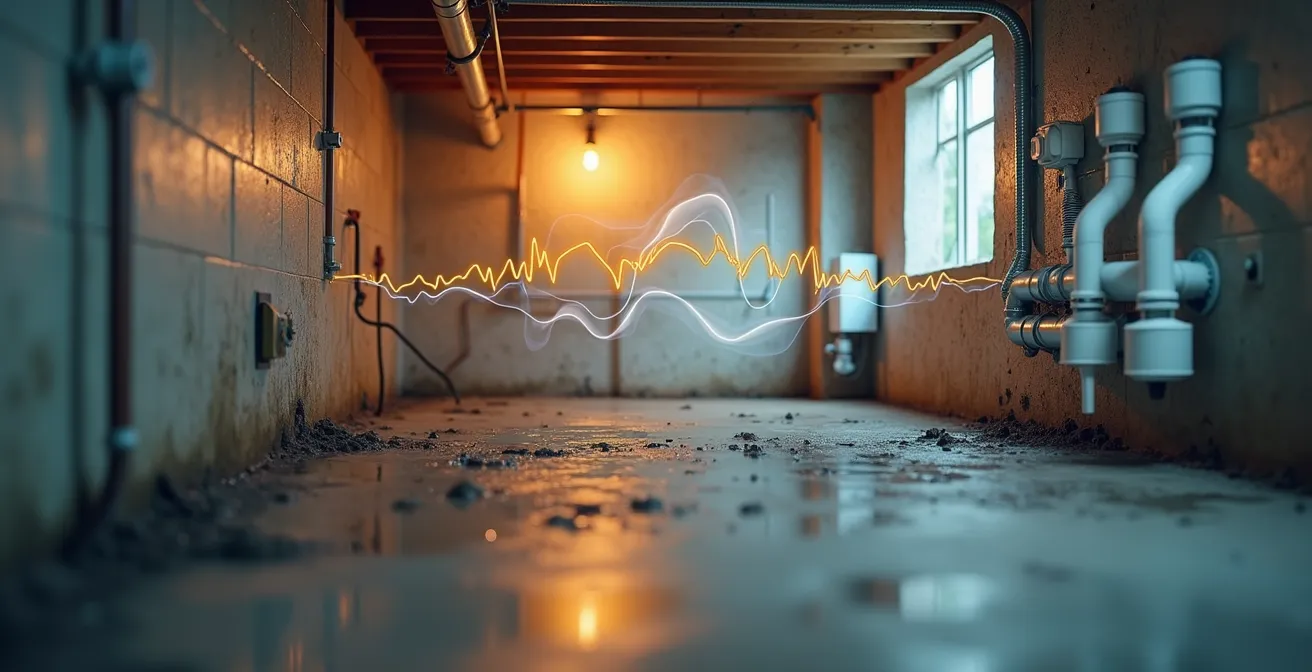
A dripping faucet or a slow drain can seem like minor annoyances—isolated problems easily fixed and forgotten. However, these common issues are often more than just localized defects; they are the language of a failing plumbing system. Viewing these symptoms as individual problems is like treating a cough without diagnosing the underlying illness. The truth is that your home’s pipes are an interconnected network, and when one part consistently fails, it often signals a deeper, systemic decay that requires a more comprehensive solution. A proactive plumbing replacement can transform a series of escalating emergencies into a strategic investment in your property’s health and safety.
Understanding these warning signs is not about reacting to the next leak, but about learning to decode your home’s signals to prevent a catastrophic failure. From the water’s color to the sounds behind your walls, each clue helps build a case for whether you’re dealing with a simple repair or a system on the brink of collapse.
Your Plumbing’s Warning Signs in 5 Key Points
- Persistent leaks and low water pressure often indicate widespread pipe corrosion, not isolated faults.
- Pipe material and age, especially in homes built before the 1970s, are critical factors in system failure.
- Hidden clues like strange noises, musty odors, and mold signal advanced plumbing distress.
- Discolored or bad-tasting water is a direct warning of internal pipe decay and rusting.
- Comparing the rising cost of frequent repairs to a one-time replacement often reveals the long-term financial benefit of an upgrade.
Navigating Plumbing Symptoms: When Is It More Than Just a Leaky Faucet?
The first step in assessing your plumbing’s health is to shift your perspective. Instead of viewing each new leak or clogged drain as a separate event, consider them as interconnected data points. A single leaky faucet might be a worn-out washer, but when you also have low pressure in the shower and rust-colored water from the kitchen sink, the narrative changes. These are not individual issues but symptoms of a system-wide problem, likely stemming from widespread pipe deterioration.
Statistics suggest this is a widespread concern, as it’s estimated that over 45% of older homes may experience frequent plumbing leaks due to aging infrastructure. Low water pressure, for instance, is often dismissed as a municipal issue or a simple clog. While these can be culprits, in an older home, it frequently signals that pipes are so corroded and scaled internally that water flow is physically restricted throughout the house. Similarly, water discoloration or strange odors are direct signs that the pipes themselves are breaking down, leaching rust and other contaminants into your water.
Frequent leaks, musty smells, stained floors, and low water pressure are critical signs that point to widespread plumbing issues rather than isolated problems.
– Michigan Plumbing Experts, Michigan Plumbing
One homeowner’s experience underscores this reality: after months of dealing with various leaks and a persistent musty smell with no obvious source, a professional inspection revealed extensive internal corrosion throughout the plumbing system. This led to a full re-piping project that ultimately resolved all the seemingly disconnected issues at once.
To help determine if your home is exhibiting signs of systemic failure, it’s helpful to perform a regular self-assessment. This simple checklist can help you spot patterns that indicate a deeper problem.
Checklist for Identifying Plumbing System Issues
- Monitor water bills for unexplained increases.
- Listen for unusual noises like banging, whistling, or gurgling.
- Inspect for stains or damp patches on walls and ceilings.
- Check water pressure regularly for unexpected drops.
The Silent Degradation: Understanding Pipe Materials, Age, and Their Failure Modes
The pipes hidden within your walls have a finite lifespan, determined largely by their material and the environment they exist in. Plumbing systems installed in homes before the 1970s often used materials like galvanized steel, which are now reaching the end of their functional life. Galvanized steel pipes corrode from the inside out, meaning they can appear stable externally while being severely restricted and weakened internally.
This silent decay is a major reason why age is a critical factor. As pipe material specialists often note, these older systems demand close scrutiny for hidden risks. Local water chemistry also plays a significant role; factors like hard water can dramatically accelerate pipe decay, causing a potential 35% reduction in pipe lifespan due to hard water. Understanding the materials in your home is key to predicting their failure.
What are the worst types of old pipes in a house?
Galvanized steel pipes, common in homes built before the 1970s, are particularly problematic as they rust from the inside out, causing low pressure, leaks, and discolored water.
Below is a summary of common pipe materials and their typical lifespans, which highlights why a home’s age is such a critical indicator for potential plumbing replacement.
| Material | Average Lifespan | Common Failure Modes |
|---|---|---|
| Copper | 50+ years | Corrosion, pinhole leaks |
| Galvanized Steel | 20-50 years | Rust, low water pressure |
| PVC/CPVC | 25-50+ years | Cracking under stress |
| PEX | 40-50 years | UV degradation, fittings failure |
Visually identifying the signs of corrosion is crucial. Pinhole leaks in copper or the characteristic rust of failing galvanized steel are clear warnings that the material integrity has been compromised.

The difference between a healthy pipe and one at the end of its life is stark. While a new copper pipe is smooth and ensures clean water flow, an old, corroded pipe not only restricts water but also contaminates it, posing risks beyond just a simple leak.
Beyond the Obvious: Unearthing Less Visible Signs of Systemic Plumbing Distress
While leaks and low pressure are clear indicators, some of the most telling signs of plumbing distress are more subtle. Your home may be communicating problems through sounds and smells long before water damage becomes visible. Persistent banging, known as a “water hammer,” or gurgling sounds from drains can reveal serious issues with pressure, blockages, or the integrity of the pipes themselves.
With some estimates suggesting up to 60% of plumbing noise-related issues indicate underlying problems, these auditory clues should not be ignored. A homeowner’s experience often highlights this; in one case, persistent banging noises led to the discovery of hidden pipe blockages and loose fittings that had gone unnoticed, preventing what could have become a major leak. This knowledge is crucial for handling emergency plumbing issues effectively.
Other subtle indicators include damp spots on walls, unexplained mold growth near plumbing fixtures, or warped flooring. An aging system can also affect the performance of your appliances and the consistency of water temperature. If your water heater seems to be failing or your shower fluctuates between hot and cold, the problem might not be the unit itself, but the corroded pipes feeding it.

These less visible signs are your plumbing system’s early warning system. By paying attention to unusual sounds and investigating damp areas, you can catch systemic decay before it leads to a catastrophic and costly failure.
Performing basic checks can help you stay ahead of potential disasters. This simple inspection routine allows you to actively listen to and observe your plumbing system for signs of trouble.
Homeowner Basic Pipe Inspection Steps
- Listen for unusual pipe noises at different times of day.
- Inspect visible pipes for dampness or corrosion.
- Check for mold growth near plumbing fixtures.
- Monitor water temperature consistency in taps.
Key Takeaways
- Chronic leaks, low water pressure, and discolored water are symptoms of system-wide pipe degradation.
- Pipe materials like galvanized steel, common in pre-1970s homes, are highly susceptible to internal corrosion.
- Auditory clues like banging pipes and subtle signs like mold are critical early warnings of plumbing failure.
- A full replacement is a strategic investment in property value, safety, and long-term financial savings.
The Replacement Equation: Proactive Investment vs. Reactive Repairs
Homeowners often fall into a cycle of reactive repairs—fixing one leak only for another to appear weeks later. While the upfront cost of a single repair is lower, the cumulative financial and emotional toll of frequent plumbing emergencies can be staggering. Calculating the long-term cost is essential. When the expense of patching up an old system begins to approach a significant fraction of a full replacement, the equation shifts in favor of a proactive upgrade.
If your repair costs surpass 50% of replacement costs, investing in a full plumbing replacement often saves money and headaches in the long run.
– Top Flow Plumbing Expert, Top Flow Plumbing
This is especially true when purchasing an older home or when a home inspection report explicitly calls out an aging plumbing system. The peace of mind that comes with a new, reliable system is invaluable, protecting your property from the risk of catastrophic water damage. Furthermore, a full plumbing replacement is not just an expense; it’s an investment that increases your home’s value and safety. A modern plumbing system is a major selling point, assuring potential buyers of the home’s long-term integrity.
When does replacing plumbing make more financial sense than repairing it?
Replacement becomes more cost-effective when the total cost of frequent, recurring repairs approaches or exceeds 50% of the price of a full system upgrade.
Consider the cost breakdown. While the national $4,080 average whole-home plumbing replacement cost seems high, one homeowner reported saving thousands annually after years of constant repair bills. If you find yourself in a similar situation, you can Explore emergency plumbing solutions to mitigate immediate risks while planning for a long-term upgrade.
| Aspect | Repair | Replacement |
|---|---|---|
| Upfront Cost | Lower ($150-$700 per repair) | Higher ($3,000-$16,000 whole-house) |
| Long-Term Cost | High if recurrent repairs needed | Lower due to fewer failures |
| Disruption | Less invasive | More invasive, longer duration |
| Lifespan | Shorter, temporary fixes | Long-lasting, modern materials |
| Property Value | No significant improvement | Increases home value and safety |
Frequently Asked Questions on Plumbing System Upgrade
How long does a home plumbing system typically last?
The lifespan of a plumbing system depends heavily on the pipe material. Copper pipes can last over 50 years, while galvanized steel, common in older homes, may only last 20-50 years before serious corrosion occurs. PEX and PVC have lifespans ranging from 25 to 50+ years.
Is it better to repair one pipe or replace the whole system?
If you have a single, isolated leak in a relatively new system, a repair is sufficient. However, if your home has older pipes (especially galvanized steel) and you experience frequent leaks, low water pressure, and discolored water, a whole-system replacement is often the more cost-effective long-term solution.
What are the main benefits of a full plumbing replacement besides stopping leaks?
Beyond preventing leaks, a full replacement improves water pressure and quality, increases your home’s resale value, eliminates the risk of catastrophic water damage from a burst pipe, and provides long-term peace of mind.
Can I inspect my own plumbing, or do I always need a professional?
Homeowners can perform basic visual and auditory inspections, such as checking for visible corrosion on exposed pipes, listening for unusual noises, and monitoring water bills. However, for a comprehensive assessment, especially for pipes behind walls, a licensed plumber is necessary to diagnose systemic issues accurately.